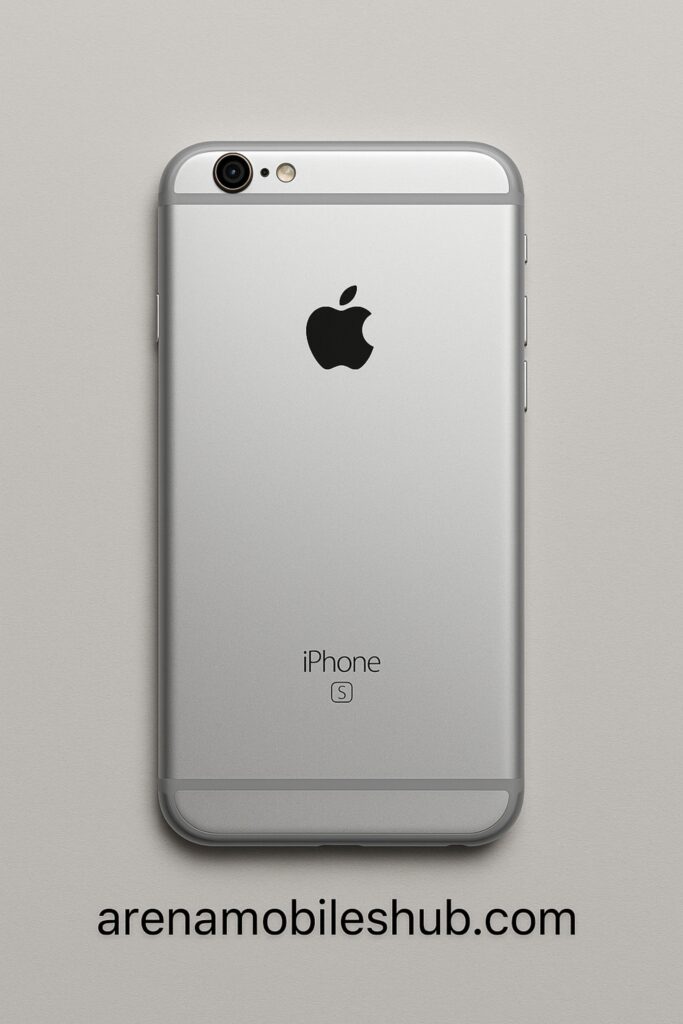The iPhone 6s may be a few generations old, but it still holds value for users looking for a reliable and affordable Apple device. With a solid camera, decent performance, and support for iOS updates for several years, the iPhone 6s remains a popular choice for budget-conscious buyers even in 2025.
iphone 6s By Arena Mobiles Hub

$84.00
Specifications
- Model: iphone 6s
- Release Date: September 9, 2015
- Body: Aluminum 7000 series, glass front
- Weight: 143 grams
- Thickness: 7.1 mm
- SIM: Nano-SIM
The iphone 6s was released by Apple in 2015. It introduced 3D Touch, allowing users to press the screen for new functions. The phone came with a fast A9 chip, improved 12MP rear camera, and a strong aluminum body. It was reliable, fast, and supported iOS updates for years.
Even years after its launch, the iPhone 6s remains a favorite for many users. Its performance is still good for daily tasks, and the camera takes clear photos. The design is slim and easy to hold. It offers great value for a budget-friendly iPhone, especially for those who prefer smaller devices.
The iPhone 6s runs on Apple’s A9 chip, offering smooth performance for everyday apps like messaging, browsing, and calling. It handles multitasking well for its age. Although it struggles with heavy gaming or demanding apps today, it’s still usable for basic tasks. The phone was ahead of its time in 2015.
The iPhone 6s features a 4.7-inch Retina HD display with good color accuracy and brightness. The 3D Touch technology added a new way to interact with the screen. Its slim, aluminum design feels premium and lightweight in hand. Many users still admire its compact size and simple, elegant look.
One of the iPhone 6s’s biggest strengths was its long software support. It received iOS updates all the way up to iOS 15, much longer than most Android phones from that era. This made it a reliable option for users who wanted security updates and access to newer iPhone features.
Display
- Size: 4.7 inches
- Resolution: 1334 x 750 pixels (~326 ppi)
- Type: Retina HD Display (IPS LCD)
- Touch: Capacitive, Multi-touch
- Other: 3D Touch support (pressure-sensitive screen)
The iPhone 6s features a 4.7-inch Retina HD display with a resolution of 1334 x 750 pixels. The screen offers sharp colors, good brightness, and wide viewing angles. It introduced 3D Touch, letting users press harder for more options. Though not OLED, its LCD panel still looks crisp and vibrant.
The iPhone 6s display delivers natural colors and decent contrast for an LCD screen. Text appears sharp, and images are clear. While it lacks modern features like HDR or OLED blacks, it still performs well in daily use. For its time, the display was among the best in compact smartphones.
The screen on the iPhone 6s performs well outdoors, offering good brightness for readability in sunlight. It supports multitouch and introduced 3D Touch, which added pressure-sensitive gestures for quicker actions. Although newer iPhones have higher resolution and better contrast, the 6s display remains smooth and responsive even after years.
Performance
- Chipset: Apple A9 (64-bit architecture)
- CPU: Dual-core 1.84 GHz Twister
- GPU: PowerVR GT7600 (six-core graphics)
- RAM: 2 GB
- Storage Options: 16 GB, 32 GB, 64 GB, 128 GB (non-expandable)
The iPhone 6s runs smoothly for basic tasks like calling, texting, browsing, and using social media. Its A9 chip and 2GB RAM were powerful for 2015 and still handle lightweight apps today. Users can open apps quickly, switch between tasks easily, and enjoy a lag-free experience in normal day-to-day use.
While the iPhone 6s handles simple games well, it struggles with modern, graphics-heavy games. The A9 chip shows its age with occasional frame drops and slow load times in newer apps. However, for casual gaming and light video editing, the phone still performs decently if not overloaded with background apps.
The iPhone 6s has proven to be reliable over time. Even years later, it doesn’t overheat easily and remains stable with proper care. It received iOS updates up to iOS 15, which helped it stay secure and functional. Overall, its performance is solid for a phone of its generation.
Camera
Rear Camera (Main):
- Resolution: 12 MP
- Aperture: f/2.2
- Features:
- Autofocus with Focus Pixels
- True Tone flash
- Live Photos
- HDR
Video:
- 4K video at 30 fps
- 1080p HD at 60 fps
- Slo‑mo 240 fps (720p)
Front Camera (Selfie):
- Resolution: 5 MP
- Aperture: f/2.2
- Features: Retina Flash, HDR
- Video: 720p HD
The iPhone 6s features a 12-megapixel rear camera that captures sharp and detailed photos. It performs well in good lighting, producing natural colors and balanced exposure. The camera supports 4K video recording, which was a big step forward in 2015. For casual photography, it still holds up surprisingly well today.
The front camera on the iPhone 6s is 5 megapixels and includes a “Retina Flash,” where the screen lights up to brighten selfies. It’s good for video calls and casual selfies, although modern front cameras offer better clarity. At the time of release, it was a major improvement over previous models.
The iPhone 6s camera app is simple and user-friendly. It includes features like Live Photos, Panorama, Slow Motion, and Time-Lapse. Autofocus is quick, and image processing is reliable. While it lacks advanced options like night mode or portrait mode, it still delivers good results for everyday users.
Battery
- apacity: 1715 mAh (non-removable)
- Talk Time: Up to 14 hours (3G)
- Internet Use: Up to 10 hours (3G/LTE)
- Audio Playback: Up to 50 hours
The iPhone 6s comes with a 1715 mAh battery, which is quite small by today’s standards. For light to moderate use like calling, browsing, or texting, it can last a full day. However, with heavy usage or gaming, the battery drains quickly and may require charging more than once a day.
The iPhone 6s supports standard 5W charging via a Lightning cable. It does not support fast charging or wireless charging, which are now common in newer models. Charging from 0 to 100% usually takes about two hours. It’s enough for basic needs but feels slow compared to modern phones.
Over time, the iPhone 6s battery tends to lose capacity, especially after years of use. Many older devices may now need battery replacement for better performance. Thankfully, iOS provides a Battery Health feature so users can check their battery status and know when it’s time for a replacement.
Connectivity
- 4G LTE, 3G, 2G
- Wi-Fi 802.11 a/b/g/n/ac, dual-band
- Bluetooth 4.2
- GPS, A-GPS, GLONASS
- NFC (for Apple Pay only)
- Lightning port (no USB-C)
The iPhone 6s supports 4G LTE, 3G, and 2G networks, providing good call quality and stable mobile internet. It works well with most major carriers worldwide. While it doesn’t support 5G, its 4G performance is still reliable for browsing, streaming, and social media on the go.
The iPhone 6s supports Wi-Fi 802.11ac, which offers decent speed for home and office networks. It includes Bluetooth 4.2 for connecting to wireless headphones, speakers, and wearables. GPS and GLONASS provide accurate location tracking for maps and navigation apps, which works well for driving or walking directions.
The phone uses Apple’s Lightning port for charging and data transfer. It does not have a USB-C port or headphone jack, but it was one of the last iPhones to include a 3.5mm headphone jack — a plus for many users who prefer wired earphones. It also supports AirDrop and Handoff for Apple ecosystem users.
Colors Availability
- Silver
- Space Gray
- Gold
- Rose Gold
The iPhone 6s was launched with four main color options: Silver, Space Gray, Gold, and the all-new Rose Gold. These colors gave users a variety of choices, from classic tones to more stylish finishes. Rose Gold, in particular, was introduced for the first time and became very popular.
All color options came with a sleek aluminum finish that gave the phone a premium and elegant look. Space Gray was favored by those who liked a darker, more professional style, while Silver and Gold offered a clean, modern feel. The Rose Gold color added a fresh and trendy vibe.
The Rose Gold version received special attention, especially from younger audiences and female users. Apple’s decision to offer more color diversity helped the iPhone 6s stand out. The colors were not just about looks—they reflected personality and style, which played a key role in the model’s marketing and popularity.
- Stay Tuned With Arena Mobiles Hub For Latest Details About Apple Phones.

The iPhone 6s, released in 2015, remains a nostalgic favorite thanks to its solid build quality, classic design, and introduction of features like 3D Touch and Live Photos.